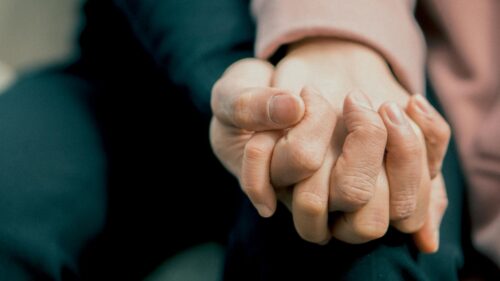From Hugs to Handshakes: When Human Touch Is A Challenge
 Human touch is an intricate and often overlooked part of social interaction. From handshakes when meeting someone new to hugs between close friends, touch plays a vital role in social bonding.
Human touch is an intricate and often overlooked part of social interaction. From handshakes when meeting someone new to hugs between close friends, touch plays a vital role in social bonding.
For autistic individuals, however, human touch can be exceptionally tricky to navigate. Touch can be too much or too little, and it can be a struggle to figure out the appropriate amount of touching, and even more so because everyone’s comfort level is different.
Many individuals on the spectrum experience touch aversion, recoiling from even the lightest touch. Some may seek out more intense touch to meet sensory needs. Understanding both perspectives of skin hypersensitivity to touch or hyposensitivity sensory perception is key to fostering positive connections across the neurodiverse spectrum.
Causes of Skin Hypersensitivity to Touch
For autistic individuals with touch aversion, a simple tap on the arm or shoulder can feel painful or jarring. This is due to common differences in sensory perception in autism that make the ordinary tactile sensations feel unpleasantly amplified. Scientific studies confirm sensory processing differences in some autistic individuals that lower tactile sensory thresholds.
Nerve bundles in the skin send heightened signals to the brain that can feel alarming rather than pleasant. Unexpected touches tend to be the most intense for autistic people who have challenges with human touch. Cringing away or withdrawing from touch altogether often serves as an instinctive shield to protect from such sensory onslaughts.
Additionally, many autistic individuals struggle (myself included) to read social cues and implicit intentions behind the touch. With underlying anxieties about properly interpreting social interaction, unexpected touches can sometimes undermine perceptions of safety and control. Reciprocity and consent around human touch remain unclear, further elevating distress.
Even a well-meaning hug from a friend or a pat on the shoulder from a teacher or co-worker may overload sensory perception while also triggering social confusion and anxiety for some individuals on the spectrum.
Creating Touch-Aversion-Friendly Environments
Well-meaning neurotypical people often intuitively reach out to touch friends, family, and acquaintances while conversing, without considering consent. But for the touch-averse autistic person, these sudden social interaction gestures can violate personal boundaries and even damage social connections.
Establishing explicit consent before any human touch is key to an autistic individual’s comfort. Simply asking “Would you like a hug?” or “May I shake your hand?” can dispel uncertainties around any sensory perception issues and prevent triggered reactions to skin hypersensitivity to touch. It also conveys fundamental respect for differences.
Spaces can also be designed to prevent accidental human touch for individuals with touch aversion, like chairs spaced further apart. Visual cues like colored wristbands for children (red = no touch, green = touch ok) or a small sign at the office (“I prefer air hugs only” or “no contact, please”) explicitly convey consent. Adaptations like these allow autistic individuals to participate socially with less anxiety about social interaction shattering sensory equilibrium.
Sensory Perception and Autistic Need for Deep Pressure

The firm hug of a trusted friend or family member or the deep squeezes from a therapist can provide emotional reassurance and positive connections, depending on the individual.
However, an autistic person may not accurately perceive the appropriate duration of contact, contributing to interactions that neurotypical individuals perceive as clingy. Direct teaching about social timing can help with aligning an autistic’s sensory needs with neurotypical social norms around human touch.
Accurate perspective-taking and tactile sense can be modeled by asking an autistic individual how a hug or touch from the other person feels— loose or tight, too long or too short? Answering these questions can cement understanding about mutually positive connections through touch.
Building Connections Despite Skin Hypersensitivity to Touch
Autistic individuals occupy the full spectrum of touch tolerance, from total aversion to a deep craving for firm contact. While generalizations about universal autistic traits exist, each autistic person has unique sensory experiences that fluctuate situationally. The only constant is the necessity of explicit consent for human touch across settings.
Sensory perception starts early through structured lessons on bodily autonomy and consent, distinguishing safe versus unsafe touch. Social stories and behavioral rehearsals shape understanding of initiating socially appropriate touch, its purpose in conversation, and when open arms indicate an interest in hugging. Sensory perception lessons also calibrate the duration of human touch, encouraging reliance on a recipient’s body language rather than internal perceptions of ideal contact.
For less verbal individuals, picture exchange communication uses images to represent “hug,” ”tickle,” and other safe touches to request or grant consent. Over time, replacing pictures with manual signs or words gives options to endorse or decline. By building advocacy skills around owning one’s body, both verbal and nonverbal autistic individuals gain confidence and agency in social interactions.
Setting Behaviors Through Environmental Controls
While social skills training empowers autistic individuals, responsibility also lies with neurotypical communicators to shape an interaction’s tone. Avoiding sudden touch unless consent is confirmed as well as adjusting communication styles based on an autistic person’s body language, helps respect personal space.
Providing physical and auditory space in conversations reduces sensory inputs that might escalate distress. Relocating to quieter spaces treats elevated anxiety with compassion rather than judgment whenever possible.
In public spaces, especially crowded ones, it can be difficult to maintain comfortable personal space void of inadvertent human contact (such as being shoulder to shoulder at a concert), but it typically can be accomplished by seeking out spaces where fewer people are gathering. Having an “escape plan” if there are too many people can help with comfort zones.
While acknowledging social distance guidelines is helpful, it isn’t always practical in crowded situations. An autistic individual should always have the choice of being part of those activities where typical social distance could be compromised and expecting crowds to adhere to no-touch requests can be challenging.
Simple environmental controls of finding a comfortable spot away from the thickest population of people (such as avoiding a concert pit, for example) can help ease tensions and still allow for participation without becoming overwhelmed.
Sensory Perception: The Role of OT and Touch Therapy
Occupational therapists (OT) can play a vital role in developing healthy touch behaviors for autistic individuals through targeted sensory integration therapy. OTs assess and treat underlying sensory needs, while also building coping strategies to navigate situations that may present touch challenges.
For those who crave deep pressure, OTs incorporate firm holds and squeezes in playful activities to meet sensory needs in a safe, controlled context. Swinging, trampolines, and crash pits allow autistics to experience stimulating but socially appropriate types of touch. Over time, the goal becomes internalizing those calming sensations to self-soothe even without external touch prompts.
For autistics with skin hypersensitivity to touch, OT gradually introduces tactile sensations as tolerable. For touch-adverse children, using textured toys, materials like play dough or finger paints, and even gentle touches with soft brushes helps recalibrate sensitivities. Coping skills during moments of tactile distress may involve self-hugs, clenching muscles, or verbal self-talk to override feelings of panic, preventing fight or flight reactions. Building familiarity and control typically lessens touch anxiety over time.
OT methods are highly personalized, adapting activities and sensory inputs to suit each autistic individual’s needs. Some may benefit from hand massages and firm hugs, while others require extremely gradual exposure to tolerate even feather-soft brushes against the skin. Tailoring therapeutic touch establishes critical foundations before navigating real-world social situations.
Touch in Romantic Contexts

Explicit teaching can help those who cannot intuitively decipher complex social cues and body language, establish consent, reciprocate interest, and demonstrate affection or positive connections.
Structured lessons outline appropriate times and places to hold hands, kiss, or exhibit other touching that indicates romantic intent. However, social interaction training around sexuality needs to remain sensitive to an autistic person’s sensory needs. For example, certain sensitive areas of the body may be off limits, or require firm pressure that neurotypicals may perceive as unpleasant.
As in friendships, explicit communication remains foundational to romantic touch for the autistic person. However, denying an autistic individual opportunities to make social and sensory mistakes also risks limiting full participation. Balancing clear guidance on mutually positive touch with room for authentic lived experience empowers autistic people in all relationships.
Positive Connections of Human Touch
Continuing to enrich sensory perception variations in autism serves to lift the veil on key challenges, and increased insights multiply appropriate supports.
Reducing the stigma of autistic differences also motivates broader society to shift social norms, balancing the give-and-take in modifying behaviors. Touch diversity within the vibrant mosaic of human experience can vary based on cultural expectations, personal preferences, and societal shifts, and not just whether someone is autistic, and sustainable empathy makes inclusive environments possible.
Whether or not you choose to have any physical contact with someone (whether socially or romantically) is entirely up to you. You own that superpower, and don’t let anyone take that choice away from you. It’s important to know what you want and feel empowered to let others know your comfort zone so you can be your authentic self!
Additional Challenges Individuals with Autism Face
Learn more about other issues that autistics face:
- Being Real Without Offending Others is an Autistic Challenge
- Autism and Organization: The Secret to Finding Calm in the Chaos
- Helpful Self-Regulation Tips for Keeping Calm and Carrying On
- New Research Reveals Autism Mental Health Linked to These Disorders
- Is Autism a Disability? Surprising Reasons for the Debate
- Social Justice Issues: Why Disability Rights Matter for Autistics
- Break Free: 10 Tips to Take A Risk and Escape Your Comfort Zone
- Autism and Holidays: Why Special Occasions Can Be Challenging
- 6 Fascinating Facts About Autism You Probably Didn’t Know
- 8 Popular Ways to Manage and Master Autistic Social Awkwardness
- Autism and Poor Hygiene: The Smelly Truth to Overcome
- Breaking Down Barriers that Challenge Autism and Friendships
- Anxiety and Autism: 5 Powerful Strategies to Conquer Emotions
- 6 Ways to Tackle Autism Fireworks Anxiety and Sensory Overload
- Autism Clothing for Sensitive Skin Can Enhance Quality of Life
- Autism After High School: Is College the Next Step?
- Climate Change and Its Alarming Impact on Autism Emotion